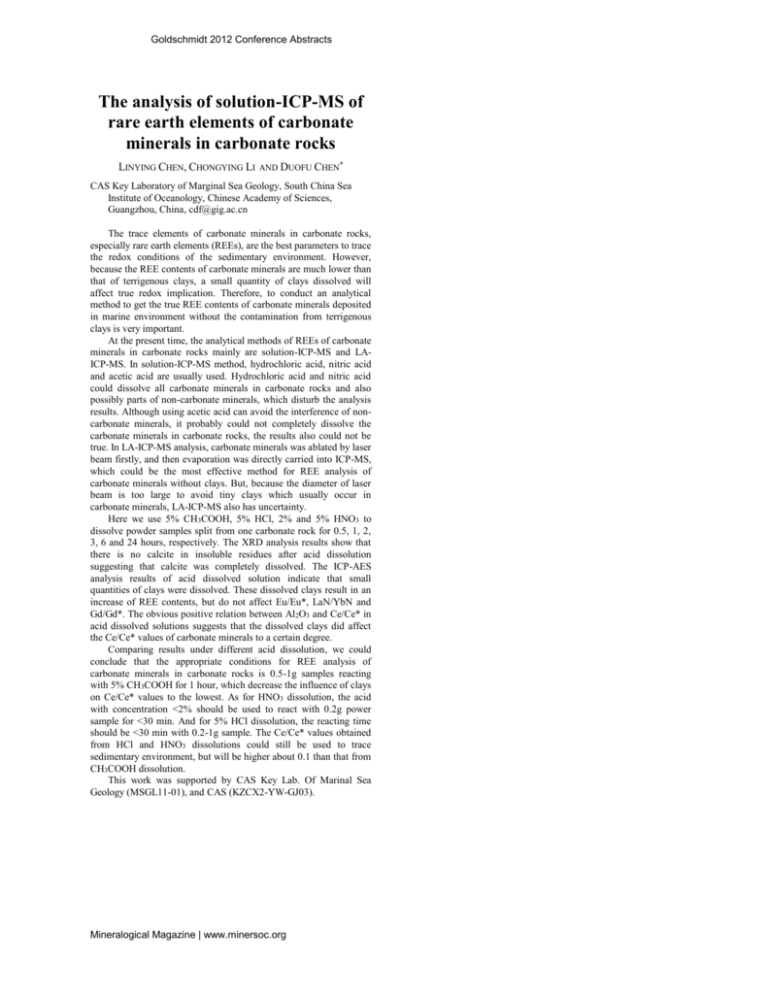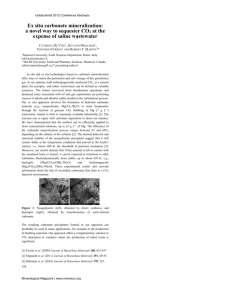Material properties and microstructure from
advertisement

Goldschmidt 2012 Conference Abstracts The analysis of solution-ICP-MS of rare earth elements of carbonate minerals in carbonate rocks LINYING CHEN, CHONGYING LI AND DUOFU CHEN* CAS Key Laboratory of Marginal Sea Geology, South China Sea Institute of Oceanology, Chinese Academy of Sciences, Guangzhou, China, cdf@gig.ac.cn The trace elements of carbonate minerals in carbonate rocks, especially rare earth elements (REEs), are the best parameters to trace the redox conditions of the sedimentary environment. However, because the REE contents of carbonate minerals are much lower than that of terrigenous clays, a small quantity of clays dissolved will affect true redox implication. Therefore, to conduct an analytical method to get the true REE contents of carbonate minerals deposited in marine environment without the contamination from terrigenous clays is very important. At the present time, the analytical methods of REEs of carbonate minerals in carbonate rocks mainly are solution-ICP-MS and LAICP-MS. In solution-ICP-MS method, hydrochloric acid, nitric acid and acetic acid are usually used. Hydrochloric acid and nitric acid could dissolve all carbonate minerals in carbonate rocks and also possibly parts of non-carbonate minerals, which disturb the analysis results. Although using acetic acid can avoid the interference of noncarbonate minerals, it probably could not completely dissolve the carbonate minerals in carbonate rocks, the results also could not be true. In LA-ICP-MS analysis, carbonate minerals was ablated by laser beam firstly, and then evaporation was directly carried into ICP-MS, which could be the most effective method for REE analysis of carbonate minerals without clays. But, because the diameter of laser beam is too large to avoid tiny clays which usually occur in carbonate minerals, LA-ICP-MS also has uncertainty. Here we use 5% CH3COOH, 5% HCl, 2% and 5% HNO3 to dissolve powder samples split from one carbonate rock for 0.5, 1, 2, 3, 6 and 24 hours, respectively. The XRD analysis results show that there is no calcite in insoluble residues after acid dissolution suggesting that calcite was completely dissolved. The ICP-AES analysis results of acid dissolved solution indicate that small quantities of clays were dissolved. These dissolved clays result in an increase of REE contents, but do not affect Eu/Eu*, LaN/YbN and Gd/Gd*. The obvious positive relation between Al2O3 and Ce/Ce* in acid dissolved solutions suggests that the dissolved clays did affect the Ce/Ce* values of carbonate minerals to a certain degree. Comparing results under different acid dissolution, we could conclude that the appropriate conditions for REE analysis of carbonate minerals in carbonate rocks is 0.5-1g samples reacting with 5% CH3COOH for 1 hour, which decrease the influence of clays on Ce/Ce* values to the lowest. As for HNO3 dissolution, the acid with concentration <2% should be used to react with 0.2g power sample for <30 min. And for 5% HCl dissolution, the reacting time should be <30 min with 0.2-1g sample. The Ce/Ce* values obtained from HCl and HNO3 dissolutions could still be used to trace sedimentary environment, but will be higher about 0.1 than that from CH3COOH dissolution. This work was supported by CAS Key Lab. Of Marinal Sea Geology (MSGL11-01), and CAS (KZCX2-YW-GJ03). Mineralogical Magazine | www.minersoc.org








